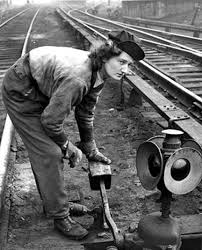Enter now to win a copy of
Iron Women: The Ladies Who Helped Build the Railroad

Although the physical task of building the railroad had been achieved by men, women made significant and lasting contributions to the historic operation. The female connection with railroading dates as far back as 1838 when women were hired as registered nurses/stewardesses in passenger cars. Those ladies attended to the medical needs of travelers and also acted as hostesses of sorts, helping passengers have a comfortable journey.
Susan Morningstar was one of the first women on record employed by a railroad. She and her sister, Catherine Shirley, were hired by the Baltimore and Ohio Railroad in 1855 to keep the interior of the cars clean and orderly. The feminine, homey touches they added to the railroad car’s décor attracted female travelers and transformed the stark, cold interior into a more welcoming setting.
Miss E. F. Sawyer became the first female telegraph operator when she was hired by the Burlington Railroad in Montgomery, Illinois, in 1872. The following year, Union Pacific Railroad executives followed suit by hiring two women to be telegraph operators in Kansas City, Missouri.
Inventress Eliza Murfey focused on the mechanics of the railroad, creating devices for improving the way bearings on the rail wheel attached to train cars responded to the axles. The device, or packing as it was referred to, was used to lubricate the axles and bearings. Murfey held sixteen patents for her 1870 invention.
In 1879, another woman inventor named Mary Elizabeth Walton developed a system that deflected emissions from the smokestacks on railroad locomotives. She was awarded two patents for her pollution reducing device.
A cattle rancher’s daughter, Nancy P. Wilkerson, from Terre Haute, Indiana, created the cattle car in 1881. Using a rack and pinion mechanism, she devised sliding partisans that separated the livestock from the food compartments and water troughs.

To learn more about the women who helped build the railroad read Iron Women

